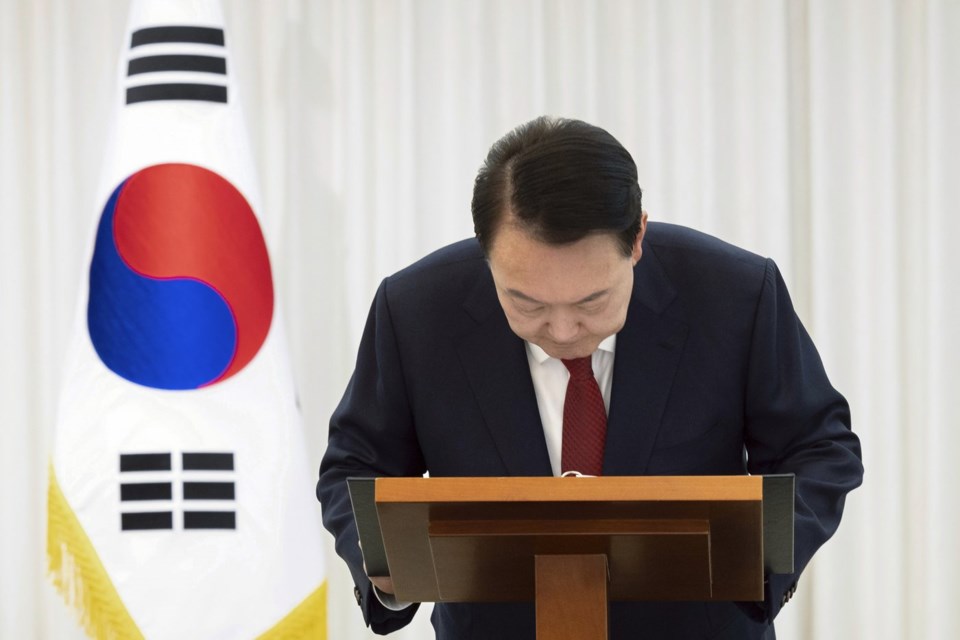SEOUL, South Korea (AP) — South Korea’s impeached President Yoon Suk Yeol defied requests by investigative agencies to appear for questioning over his short-lived martial law decree, as the Constitutional Court began its first meeting Monday on Yoon's case to determine whether to formally unseat or reinstate him.
A joint investigative team involving police, an anti-corruption agency and the Defense Ministry said it wants to question Yoon on charges of rebellion and abuse of power in connection with his ill-conceived power grab.
The team on Monday tried to convey a request to officials at Yoon's office or residence but they refused to accept it, according to the Corruption Investigation Office for High-Ranking Officials.
Agency investigator Son Yeong-jo cited presidential secretarial staff at Yoon's office as claiming they were unsure whether conveying the request to the impeached president was part of their duties. Son said his team had also mailed the request to Yoon, but declined to provide specifics when asked how investigators would respond if Yoon refuses to appear.
Yoon was impeached by the opposition-controlled National Assembly on Saturday over his Dec. 3 martial law decree. His presidential powers have been subsequently suspended, and the Constitutional Court is to determine whether to formally remove him from office or reinstate him. If Yoon is dismissed, a national election to choose his successor must be held within 60 days.
Yoon has justified his martial law enforcement as a necessary act of governance against the main liberal opposition Democratic Party that he described as “anti-state forces” bogging down his agendas and vowed to “fight to the end” against efforts to remove him from office.
Hundreds of thousands of protesters have poured onto the streets of the country’s capital, Seoul, in recent days, calling for Yoon’s ouster and arrest.
It remains unclear whether Yoon will grant the request by investigators for an interview. South Korean prosecutors, who are pushing a separate investigation into the incident, also reportedly asked Yoon to appear at a prosecution office for questioning on Sunday but he refused to do so. Repeated calls to a prosecutors’ office in Seoul were unanswered.
Yoon’s presidential security service has also resisted a police attempt to search Yoon's office for evidence.
Also Monday, the Constitutional Court met for the first time to discuss the case. The court has up to 180 days to rule. But observers say a ruling could come faster.
In the case of parliamentary impeachments of past presidents — Roh Moo-hyun in 2004 and Park Geun-hye in 2016 — the court spent 63 days and 91 days respectively before determining to reinstate Roh and dismiss Park.
Kim Hyungdu, a court justice, told reporters earlier Monday that the court will “swiftly and fairly” make a decision in the case. He said Monday’s court meeting was meant to discuss preparatory procedures and how to arrange arguments at formal trials.
Court spokesperson Lee Jean later said the court's first pretrial hearing is set for Dec. 27.
Upholding Yoon’s impeachments needs support from at least six out of the court’s nine justices, but three seats are vacant now. This means a unanimous ruling by the court’s current six justices in favor of Yoon's impeachment is required to formally end his presidency. Kim said he expected the three vacant seats to be filled by the end of this month.
Prime Minister Han Duck-soo, who became the country’s acting leader after Yoon's impeachment, and other government officials have sought to reassure allies and markets after Yoon’s surprise stunt paralyzed politics, halted high-level diplomacy and complicated efforts to revive a faltering economy.
Democratic Party leader Lee Jae-myung urged the Constitutional Court to rule swiftly on Yoon’s impeachment and proposed a special council for policy cooperation between the government and parliament. Yoon’s conservative People Power Party criticized Lee’s proposal for the special council, saying that it’s “not right” for the opposition party to act like the ruling party.
Lee, a firebrand lawmaker who drove a political offensive against Yoon’s government, is seen as the frontrunner to replace him. He lost the 2022 presidential election to Yoon by a razor-thin margin.
Yoon’s impeachment, which was endorsed in parliament by some of his ruling party lawmakers, has created a deep rift within the party between Yoon’s loyalists and his opponents. On Monday, PPP chair Han Dong-hun, a strong critic of Yoon's martial law, announced his resignation.
“If martial law had not been lifted that night, a bloody incident could have erupted that morning between the citizens who would have taken to the streets and our young soldiers,” Han told a news conference.
Yoon’s Dec. 3 imposition of martial law, the first of its kind in more than four decades, harkened back to an era of authoritarian leaders the country has not seen since the 1980s. Yoon was forced to lift his decree hours later after parliament unanimously voted to overturn it.
Yoon sent hundreds of troops and police officers to the parliament in an effort to stop the vote, but they withdrew after the parliament rejected Yoon’s decree. No major violence occurred.
Opposition parties have accused Yoon of rebellion, saying a president in South Korea is allowed to declare martial law only during wartime or similar emergencies and would have no right to suspend parliament’s operations even in those cases.
Kim Tong-hyung And Hyung-jin Kim, The Associated Press




